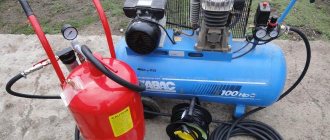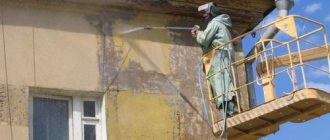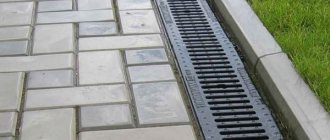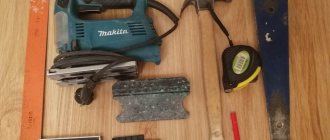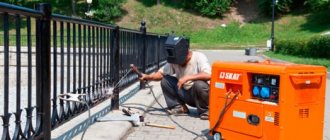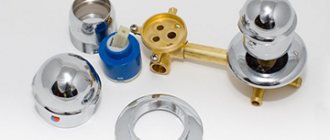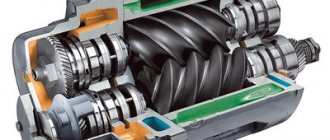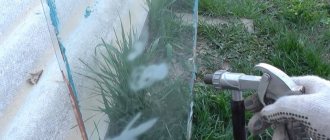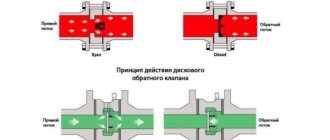The compressor used to equip the sandblasting machine is the most important element, the correct choice of which largely determines the efficiency of the entire system. The technical characteristics of this device also have a direct impact on the performance of the processing performed and on such an important parameter as the consumption of abrasive material.
A sandblasting unit and a compressor are two essential components of one metalworking system
Compressor selection
The sandblasting compressor is the most expensive device among all the elements of the system used to perform such a task. When equipping a device for sandblasting, many, guided by a natural desire to save money, purchase the cheapest compressors, the technical characteristics of which do not meet the required parameters.
The use of a compressor, the technical parameters of which do not correspond to the characteristics of the sandblasting machine used, leads to the fact that the speed of processing is significantly reduced, the consumption of abrasive material per unit of surface area processed increases, as a result, the deadlines for completing the work are missed and their cost increases.
That is why specialists, when choosing a compressor for sandblasting, evaluate not only the volume of work to be carried out, but also the deadlines that must be met. To select a compressor, special tables are most often used, which show the ratios of such parameters as:
- the pressure that the compressor is capable of providing;
- level of compressed air consumption by a sandblasting machine;
- consumption of abrasive material per unit area of the surface being treated;
- speed of processing.
Abrasive, air consumption and productivity
The data on the consumption of abrasive material, which are indicated in such tables, are indicative for the reason that the value of this parameter is influenced by many factors. Such factors, in particular, are: the type of surface being treated, the nature and thickness of the layer of dirt or old coating being cleaned, the height to which it is necessary to raise the abrasive mixture, the experience and qualifications of the work performer. Despite the not very high accuracy of this parameter given in the tables, they give an idea of which compressor to choose.
Compressors for sandblasting
Sandblasting is a process for processing metal, stone or glass products.
The purpose of this treatment is to modify the surface of these materials using sand (or other abrasive) which is sprayed with a strong stream of compressed air. For example, sandblasting equipment may be needed for work in automobile workshops or during repairs, when you need to remove plaster from brickwork, etc. The scope of application of these devices is extremely wide. For such work, you not only need a sandblasting machine, you also need a sandblasting compressor that will supply air to the machine. Depending on the purpose, purpose of the device and the scope of work, the compressors themselves and their price differ.
There are several areas of application of this equipment:
- Technical work to clean the surface from old coating;
- All types of repairs when you need to clean the surface of varnish or paint;
- Working with metal when you need to get rid of corrosion;
- Glass production, specifically its frosting using sandblasting.
In addition, working with air and abrasive is necessary when repairing machines, in the production of ships, and parts for any devices.
Important parameters
If we evaluate the importance of two main characteristics of any compressor: performance, measured in the volume of air supplied per unit of time, and the pressure under which such air is supplied to the sandblaster nozzle, then we can conclude that they are both important.
If we talk about compressor performance, which can be measured in units such as liter/min and m3/min, then it should be noted that this parameter affects the speed of processing and the quality of the working mixture consisting of abrasive material and air. Compressor equipment, characterized by high performance, makes it possible to use nozzles with holes of larger diameter, thereby increasing the diameter of the treatment spot and, accordingly, the speed of its implementation. Most models of modern sandblasting machines operating on the pressure principle require compressors capable of providing productivity in the range of 2.2–17 m3/min.
Compressor performance calculation
The choice of a compressor based on the pressure it can provide depends primarily on the characteristics of the surface being treated. Thus, to perform effective sandblasting of structures made of concrete, brick and natural stone, you need a compressor that can provide a pressure of about 3-5 bar, and for high-quality cleaning of metal surfaces - 5-8 bar. Higher pressure (about 9–12 bar) is required in cases where it is necessary to remove a thick layer of old coating or material that is highly abrasive from the surface being treated. A compressor capable of providing such pressure will also be required if the abrasive mixture needs to be supplied over a significant distance: over 60 meters.
When a sandblasting machine operates, the main part of the pressure is lost not in the hose supplying compressed air from the compressor, but in the hose through which abrasive material is supplied from the container. That is why, if it is necessary to perform sandblasting work at a considerable distance from the compressor unit, this distance must be covered by the length of the air hose, and the hose for supplying the abrasive material should be kept to a minimum length.
Basic options to choose from
Based on experiments, it has been established that in order to process a metal surface with an area of several square meters, it is necessary to provide a continuous supply of an abrasive jet mixed with air weighing 0.05...0.07 kg/s. The volumetric ratio between sand and air is (0.01...0.012):1. It turns out that to supply sand you need 100 times more air volume.
To provide such an amount of compressed air, the compressor performance must be 12...15 l/s (720...900 l/min). An important parameter will be the pressure created by the pneumatic machine.
In the theory of gas flow through a nozzle, the formula is used:
, m/s
Where:
- k – adiabatic index. For diatomic gases (a gas mixture of nitrogen and oxygen is a mechanical compound of diatomic gases) k = 1.4;
- pcr – critical gas pressure in front of the nozzle, bar;
- p₁ – pressure of the ambient gas into which the outflow occurs, bar;
- v₁ – specific volume of air, kg/m³.
To clarify the critical pressure, use the formula:
For diatomic gases, the critical value is βcr = 0.528. In a conventional expanding nozzle, it is impossible to achieve speeds greater than the speed of sound for a given gas at the appropriate temperature. Therefore, talk about the need to have high pressure at the nozzle inlet is unfounded.
At excess pressure pcr = 2.1...2.2, an air flow velocity equal to wcr = 290...310 m/s is achieved. To obtain a higher exhaust velocity, expanding Laval nozzles are used. But when they work, a sound similar to gunshots will come out. It will be extremely dangerous to be near such a working installation; your eardrums will not withstand it.
Screw or piston compressor unit?
Piston compressors, which supply compressed air to the system with significant surges, are rarely used to complete sandblasting machines. Due to such jumps, the abrasive material mixes unevenly with the air flow, forming numerous lumps that not only reduce the pressure of the abrasive jet, but also clog the nozzle of the device. You can eliminate pulsations of air pressure in the system when using a piston compressor if you include a receiver in the system and select a compressor unit that can provide greater pressure than is required for the operation of a sandblasting machine. Another disadvantage of such compressors, which in case of urgent need can be used to perform short-term sandblasting work, is that they are characterized by a significant removal of compressor oil.
When choosing a compressor, consider the average service life, depending on the type of equipment
Screw-type compressor units, mainly used to complete sandblasting machines, do not have all such disadvantages. Such installations, which are economical to use and maintain, are capable of providing the sandblasting machine with compressed air for a long period of time, the pressure level of which remains stable.
Choosing the right hoses
The equipment of the apparatus plays a major role in the formation of the final parameters of the air-abrasive sandblast jet. These are hoses, various connecting elements, connectors, and adapters. To ensure that the compressor power is used optimally, it is recommended:
- do not allow the diameter of the air passage channel to change along the route;
- minimize the number of transition elements;
- use durable, non-kink hoses with a diameter that is 3-4 times larger than the working diameter of the nozzle.
The length of the hose from the air station to the sandblasting gun should be kept to a minimum. A mobile industrial compressor necessarily takes this feature into account.
If we are talking about a semi-handicraft installation, it is recommended to increase the length of the hoses by extending the hose running from the compressor to the abrasive-air mixture mixing unit. You can further increase productivity, reduce downtime and obtain the desired, stable pressure for sandblasting by choosing the type of supercharger.
Diesel or electric compressor?
Sandblasting machines today can be equipped with compressor units driven by electric or diesel engines. Which of these compressors to choose depends on a number of factors. It is clear that it will not be possible to use an electric compressor if there is no possibility of connecting to the electrical network. Meanwhile, autonomy and mobility are not the only advantages of diesel compressors.
A modern diesel compressor is a powerful unit equipped with various systems that ensure efficient operation with any tool.
Most modern models of such devices are equipped with an effective system for adjusting their performance, which works on the following principle: at the moment when the consumption of compressed air by the sandblasting machine decreases, such a system automatically reduces the speed of the installation’s drive engine; Accordingly, when compressed air consumption increases, engine speed also increases. Similar systems can also be installed on electric compressors, but due to the design features of such devices they are much more expensive.
The advantages of electric compressors include the simplicity of their design; they are more economical to operate and maintain. Among such compressors on the modern market there are both stationary and mobile models, transported using a special chassis with which they are equipped. A limitation for the use of electrical installations is also that for the sandblaster to operate effectively, a compressor is required, the engine of which has a power in the range of 22–100 kW. Not every electrical network can withstand connecting such a motor.
Compressors operating from a 220-volt network are practically never equipped with motors more powerful than 3 kW
If you choose which compressor to purchase, taking into account the economic component of its use, the choice of electrical devices will be more preferable.
Compressors for work
Modern compressors for technological equipment are manufactured in piston or screw versions. When screw compressors operate, the gas compression process occurs due to the rotation of two screws.
Screw compressor design:
Screw compressor structure: 1 – housing; 2 – rotor screw; 3 – roller type bearing; 4 – ball bearing; 5 – bearing support; 6 – sealing gland; 7 – end cover; 8 – a pair of gears of the gearbox.
Working process of a piston compressor: 1 – suction valve; 2 – discharge valve
The process of operation of a compressor is most easily understood by considering the diagram of a piston device. Available:
- cylinder;
- piston;
- crankshaft;
- intake and discharge valves located in the cylinder head.
- When the crankshaft rotates, the piston makes reciprocating movements. In this diagram they move up and down.
- When the piston moves downwards, a vacuum is created inside the cylinder. As a result, the suction valve opens. Air from the environment enters the cylinder.
- When the bottom dead center is reached, the volume expansion process stops. The piston begins to move upward.
- The pressure inside increases. As a result, the intake valve closes.
- When the pressure increases above a certain value, the discharge valve opens. Pressurized air is forced into the exhaust pipe.
- When the pushing cycle is complete, the valves close. In the future, all work is repeated.
Structurally, industrial installations have not one, but several cylinders. Therefore, during their operation, work occurs in a smooth mode. The flywheel balances vibration.
Multi-cylinder piston compressor design:
When a screw compressor operates, air is sucked in from the environment. The profiles of the screw pair are made in such a way that when gas is pushed into the spaces between the screws, the volume constantly decreases. There is a gradual compression of the working fluid.
The cycle is completed without sudden back-and-forth movements. Wear in this design is minimal. Therefore, most users consider using screw compressor machines. Their higher reliability has been proven over time. Therefore, if you have the opportunity to choose one type or another, then it is better to opt for screw systems.
Attention! Gas compression occurs in a short period of time. Heat exchange with the environment is limited. Therefore, in calculations it is assumed that the processes of compression and pushing of air occur adiabatically (without exchanging heat with the environment). Therefore, compressed air heats up by 300...450 ⁰С.
For normal operation of compressor units, cooling is necessary. Industrial devices have a water cooling jacket. Smaller units are cooled by a fan that blows air over the finned surface of the cylinder and cylinder head.
Recommendations for operating compressors in winter conditions
Those who are going to use a compressor as part of a sandblasting system should definitely know how to avoid the formation and concentration of moisture-oil condensate in the lines, which not only reduces the performance of the device, but can also lead to its complete stop. The presence of such condensate in the supply lines leads to the wetting of the abrasive material, its sticking and the formation of lumps, and if metal shot is used as such material, then the condensate contributes to its corrosion and, as a result, to a decrease in its quality characteristics. Compressor oil, which is also present in the condensate, if it gets on the surface being treated, negatively affects the quality of the cleaning performed.
When operating the compressor in winter, replace the “summer” oil with oil with a pour point of at least 25 degrees
In order to remove already formed condensate from the system, special moisture-oil separators are used, operating on the principle of a cyclone separator, but they are unable to stop the process of its formation. To solve this problem, various devices can be used in sandblasting systems, the most common of which include:
- compressed air coolers;
- coalescent filters;
- refrigerated dryers.
You can make a moisture separator yourself, for example, from an oil filter from a Volgov engine
When operating compressor units at low temperatures (from minus 5 degrees), they must be additionally equipped with pre-heaters and “cold start” systems. Naturally, the oil used in compressors in such cases must also be designed for winter operation.
Compressor performance calculation
Performance is perhaps the most important characteristic of a compressor - the volume of air compressed per unit of time. Air is the most important element in sandblasting, so it is important to select a compressor with a small capacity reserve.
The best option is to display an air flow rate equal to 70-90% of the maximum compressor performance. In the compressor passport, the performance value is always indicated, but there is a formula for checking:
Q=(Q1*Ki1+Q2*Ki2+Q3*Ki3+...+Qn*Kin)*Kc, where: Q is the required compressor output capacity, Q1...Qn is the air flow rate of each consumer, Ki1...Kin is the utilization factor of each consumer, total: Kc - equipment synchronism coefficient.
Used compressor equipment
When deciding what compressor equipment to buy in order to spend less money, many decide to buy a unit that has already been used. Acting in this way, you should take a very responsible approach to choosing equipment so as not to end up in a situation where you have to constantly repair your compressor installation. It should also be borne in mind that a compressor that has already been operating for some time is not capable of providing the characteristics specified in the data sheet for new equipment. This state of affairs is due to the fact that any equipment used is subject to natural wear and tear, which certainly does not affect its efficiency in the best way.
The advantage of buying a used compressor is the ability to purchase a more powerful unit for little money.
Used compressors, in addition, are characterized by increased fuel consumption, which leads to an increase in the cost of sandblasting work. One should not discount the fact that such equipment may fail at any time, which will lead not only to additional costs for its repair, but also to delays in completing work, and this is very critical in many situations. The average normal life of compressor equipment is 7–10 years, so purchasing a compressor that has already worked for such a period of time is simply not practical.
Optional equipment
When working with sandblasting equipment, we must not forget about the danger of accumulation of rust and other deposits. Therefore, it is important to promptly clean equipment from polluting particles, dust, sand and other contaminants. You should also not forget about the possible humidity of the atmosphere, which, in addition to water, may contain various oils that can interfere with the operation of the device and shorten its service life.
In order to prevent the occurrence of this type of pollution, a special filtration system has been created, which consists of the following equipment:
- Oil and moisture separator – ensures the absence of water and oil in the air duct. Install it in the air inlet of the sandblasting machine;
- Coalescence filter – protects the device from water ingress, thanks to the fact that it retains water vapor and combines it into droplets. Install this device in the outlet of the compressor;
- Air cooler – cools the air to condense moisture.
All this equipment is recommended for installation so that your sandblaster and compressor last much longer.
Popular brands
Quite a lot of companies offer compressors for sandblasting:
- Atlas Copco Compressors of this brand are reliable and energy efficient. Their range includes lines that are ideal for painting and sandblasting work. These are the XAMS, XAHS, XATS and XAVS lines: The characteristics of the XAMS 287 Dd, XAMS 407 Cd, XAMS 527 Cd models are pressure equal to 8.6 bar and power, which, depending on the model, can be from 128-224 kW.
- For models XAVS 166 Dd, XAVS 307 Cd, the pressure is 14 bar and the power is 104-186 kW.
You can find all these models and many others in our online store. If you have any questions, you can contact our managers.
Homemade compressors
For those who like to do something with their own hands and want to save a lot on purchasing a commercial compressor, there is a good option: make a homemade device that will allow you to effectively perform simple sandblasting at home.
Compressor circuit
As the main element of a homemade device for producing compressed air, which will determine its technical characteristics, you can use ready-made compressors from the pneumatic brake drive of old MAZ and ZIL cars (130–157). Such compressors are also available in equipment from the MTZ and GAZ brands, but they are low-performance, and the devices from KAMAZ vehicles require significant modification. As a receiver that will need to be installed on such a device, you can use a regular gas cylinder with a capacity of 50 liters. An electric motor of both 220 and 380 V is suitable to drive the compressor head.
With your own hands, for such a homemade compressor, you only need to make a frame on which all the component elements of the device are assembled into a single structure.
More on the topic: > Do-it-yourself sandblasting: drawings, videos, manufacturing instructions > Sandblasting nozzle: rules for choosing and making it yourself > Sandblasting from Karcher: nozzle for a high-pressure washer
How to best operate your compressor
When working with a sandblasting machine, it is necessary not only to achieve high labor productivity and the required surface finish. The operator is always faced with the following list of tasks.
- Achieve as many regeneration cycles as possible for the abrasive material.
- Do not allow undesirable effects on the treated base.
- Work in any weather.
- Reduce dust ingress into the inlet tract.
The above problems will be solved by industrially produced components, some of which must be included in the air station piping.
Neutralization of condensate
Condensation always occurs at the pressure conversion boundary. When air is taken in and compressed in the supercharger, condensate is sure to form, which enters the outlet path. Arrival of air droplets:
- causes clumping of abrasive sand, which reduces the quality of processing and can disrupt the operation of the mixing unit;
- causes corrosion of some abrasive materials, in particular steel shot, which reduces the number of recovery cycles and economic efficiency.
Condensate can be neutralized using a compressed gas cooler, after which a cyclone separator-moisture trap is installed . This set of equipment is installed at the outlet of the supercharger (recommended) or receiver.
Cyclone separator-moisture trap
Neutralization of oil
The presence of oil in the output air stream is a common feature of piston devices. The mechanics of the action of such impurities on the abrasive mixture is similar to the effect of condensate. Except that oil is non-corrosive. However, it can be extremely undesirable during surface treatment.
When oil gets on the base, it can cause a variety of unpleasant consequences: from disrupting the chemical composition, reducing adhesion, to destruction or color change. To neutralize such impurities in the output air flow, a special trap is needed. This unit must be installed directly at the compressor outlet.
Work in winter
Temperature drops below 0% are dangerous for electrical devices. A further decrease in performance may cause problems starting internal combustion engines. It is especially difficult to start a diesel engine in cold weather. Therefore, if you plan to work outdoors in winter, you should definitely take measures to ensure proper operating conditions for the compressor.
Electrical devices are enclosed in a heated housing. You can make such a system yourself using temperature sensors and a special heating cable.
Advice! For compressors with an internal combustion engine, it is recommended not to create ineffective and often dangerous homemade products. Compressors of this class must be purchased with complete winter packages.
Reducing the amount of dust in the inlet tract
The easiest way is to eliminate the risk of dust getting into the compressor. Schemes are used for this.
- An underwater hose is connected to the compressor station, where the supercharger and receiver are combined into a single structure, the end of which extends far beyond the working area.
- In systems where the compressor and receiver are separated, it is possible to lengthen the route coming from the supercharger. The latter is placed away from the working area. It is not recommended to extend the hose from the receiver to the sandblasting gun.
In some cases, a car or special industrial filter can be used to clean the inlet air from dust. Such equipment will require periodic cleaning of the unit or replacement of the working element. However, in cases where it is not possible to purify the inlet air in any other way, it is quite rational to incur such expenses.
How to avoid condensation?
Moisture-oil condensate formed in the pipeline and in the equipment can seriously reduce the productivity of the sandblasting machine, and in some cases, completely stop its operation. High-end sandblasting equipment is always equipped with cyclone separators (moisture-oil separators), but they only help remove condensed liquid and cannot completely prevent condensate from getting into the abrasive. When wet, most abrasives cake and lose their free-flowing properties, this negatively affects the quality of dosing, reduces the cleaning speed and increases abrasive consumption. Metal shot in the presence of moisture oxidizes and wears out faster. And getting condensed compressor oil onto the surface to be cleaned is also extremely undesirable.
To eliminate the bulk of the condensate, in most cases a compressed air cooler and a cyclone separator or coalescent filter are sufficient, but in some cases this is not enough and the use of refrigerated dryers is recommended. This type of equipment can be either built into compressors or separately mounted.
How to choose a blower for sandblasting
The compressor is the most expensive element of a sandblasting unit, so you need to buy it after carefully assessing all the parameters. Many users purchase cheap devices to save money, but their technical characteristics may be low. This leads to a strong reduction in the sandblasting speed, increased abrasive consumption and increased cost.
Main settings
The most important technical characteristics of a compressor are the pressure it can provide and the level of compressed air consumption. Also, when selecting a device, it is necessary to evaluate the consumption of abrasive material per unit area and the processing speed.
What is more important: pressure or air volume?
When assessing the performance of the compressor (the volume of air supplied per unit time and the pressure with which the air is supplied to the nozzle), we can draw the following conclusion: both characteristics are important and determine the overall efficiency of the sandblaster. Nevertheless, the quality of the air-abrasive mixture and the speed of surface grinding more strongly depend on productivity. If the volume of air in cubic m/min will be significant, larger nozzles can be used, which will also speed up the operation of the sandblasting machine. For most models of sandblasters, compressors with a capacity of 2.2–17 cubic meters are used. m/min.
When a supercharger is selected based on pressure, surface characteristics must be taken into account. Here are the required pressures and the most common materials to be processed:
- stone, brick, concrete - 3–5 bar;
- metal - 5–8 bar;
- thick-layer, abrasion-resistant coatings - 9–12 bar;
- any materials processed from a distance of more than 60 meters - 9–12 bar.
The working pressure in the abrasive supply hose is reduced, and losses are reduced by choosing a hose of the shortest possible length. The shortened distance is covered by increasing the compressed air hose.
Screw or piston compressor unit: what to choose
Piston blowers are much less commonly used for sandblasting machines. Their productivity is quite high, but the air is usually supplied in jerks, with pulsation, so the abrasive can accumulate into lumps. As a result, the pressure drops and the nozzle ejects the air-sand mixture unevenly. To eliminate this problem, you have to install a receiver (air collector).
Another unpleasant feature of piston superchargers is the appearance of water-oil condensate, which causes clumping of the abrasive, and sometimes the failure of the entire installation. Due to the high degree of compressor oil removal, such devices are less in demand when sandblasting materials.
Screw compressors that are free of these shortcomings are common in this industry. Instead of pistons, they have two worm gears that rotate in opposite directions. The advantages of such devices:
- long continuous work;
- air supply with minor pressure drops;
- economical operation and maintenance;
- low vibration indicator;
- absence of air shocks and abrasive clumping;
- Very quiet operation thanks to low noise level.
Diesel, petrol and electric supercharger
Sandblasting units can be equipped with diesel or electric motors. The advantages and disadvantages of devices, as well as the final choice, are influenced by many factors. A modern diesel compressor is a powerful unit, the operation of which does not depend on the connection to the electrical network. Most models are equipped with a performance control system: when air consumption decreases, the speed of the drive motor is automatically reduced, and vice versa.
The main advantages of gasoline superchargers are mobility and autonomy. If it is impossible to connect the device to the network, the use of gasoline compressors is sometimes the only option for sandblasting. If you want to assemble a sandblaster yourself, you should pay attention to such devices. However, due to the high price of fuel, the use of electric compressors is cheaper, and the rationality of using diesel ones is not always visible. Also, at temperatures below +5 degrees, you will have to additionally equip a preheating and cold start installation - without them, the supercharger will not work.
Electric compressors are considered the most economical; they are simpler in design, operation and maintenance. Good devices have a power from 22 to 100 kW, but not every electrical network can support their connection. For on-site use, mobile systems on chassis are available for sale.
Low temperature operation
If you are going to use the compressor in winter, care should be taken to prevent the formation of moisture-oil condensate and its concentration in the system. Otherwise, there is a high risk of reducing the unit’s performance and the quality of surface cleaning, as well as damage to the compressor.
When operating the device in the cold season, it is worth purchasing “winter” oil instead of “summer” oil. The pour point of such a liquid is about –25 degrees, so the device will work normally, without failures. Equipping the supercharger with a pre-heater and a cold start system will also help prevent problems during cold weather.
Which compressor lasts the longest?
When sandblasting, a lot of dust appears, especially when using regular (river) sand. This dust consists of broken abrasive particles that are harmful not only to humans, but also to the compressor itself. Its penetration into screw blocks reduces the life of the device, so cleaning surfaces should be carried out at a long distance.
Some compressor models are equipped with additional filters, which seriously increases the service life of screw units. Such installations are more expensive, but will last much longer. It is better to buy a sandblasting compressor from a well-known brand that has service centers, and spare parts for the devices are sold in the retail chain.
New or used compressors
Most manufacturers guarantee trouble-free operation of superchargers for 7–10 years, after which their service life is exhausted. When purchasing a device that has already been used, you need to keep these terms in mind. The seller may show technical documentation indicating the main operating parameters of the compressor, but these figures are often lower in reality. The reason is the natural wear and tear of equipment, reducing its efficiency. Only diagnostics using a flow meter will allow you to find out the real picture.
For diesel compressors, fuel consumption increases significantly after only 3 years of active operation. The financial costs of operating such a device will be significantly higher, as will the costs of possible repairs and maintenance. Any compressors older than 10 years are a waste of money and are not worth purchasing at all. They can break during sandblasting, and most often repairs are impractical due to the cost. When planning a large amount of work, there is no need to consider the option of buying used equipment, and for one-time grinding, you can look for a compressor for little money, but not too old in production.
Sandblasting machine device
Any sandblasting machine consists of the following elements:
- a compressor that creates the required air flow pressure;
- storage receiver;
- a gun through which a stream of sand is directed onto the surface to be treated;
- container with sand or other abrasive material;
- automation and control system;
- connecting hoses.
The automation system is designed to control the pressure in the supply to the gun. There is also an automated compressor emergency shutdown system in case of problems in the work area. For example, when the work gun was accidentally released from the hands or in the event of a sandblaster falling.
The control system ensures that the compressor is turned on and off. Also, with its help, the equipment is switched to idle and operating modes. Sometimes it is located not only in the working area, but also in areas of additional sandblasting maintenance. For example, the equipment can be controlled by an assistant who monitors the level of sand in containers. He does this either independently or at the command of the sandblaster.
Connecting hoses are a very important element of sandblasting. The power and performance of the device depends on them. When selecting or manufacturing sandblasting hoses, the pressure they can withstand is taken into account. An equally important parameter is their diameter and internal resistance. The productivity and power of sandblasting is significantly affected by the length of the hoses.
Operating principle of sandblasting machine
The operating principle of sandblasting may vary slightly depending on the type, but most of them work as follows:
- the compressor creates air pressure that accumulates in the receiver;
- when the pressure required for sandblasting is created, the air flow is supplied to the gun;
- after air is supplied to the gun, a vacuum appears in it, which draws the abrasive substance from the container. Sand can also be forced into the gun;
- then the air-sand mixture is ejected from the gun with high acceleration and directed onto the surface to be treated.
Some sandblasters may work differently, but the operating principle described is the most common.
Advantages and disadvantages
In most cases, a cooler is sufficient to clean the air from condensation, but sometimes special refrigeration systems are used. When working on the road, the question often arises: what type of compressors should I give preference to, diesel or electric?
Both the first and the second have several positive and negative features that should be taken into account when choosing equipment.
One of the indisputable advantages of diesel engines is autonomy. You are absolutely not tied to power sources. Plus, most of these compressors have a built-in automatic engine speed control system, which allows you to save fuel while reducing air consumption. A similar system for electric compressors is much more expensive. However, the cost of fuel is quite high. In this regard, diesel compressors should be used exclusively in cases where there is no access to an industrial power supply network.
Pros and cons of using electric compressors
Electric drive units are much simpler and cheaper to operate. Quite a large part of the proposals assume a mobile chassis. But at the same time, you will not always have access to the power grid. And even if there is one, it is not a fact that the line will withstand the load of the compressor electric motor. In many models, the motor is so powerful that you cannot plug it into a regular outlet. The engines of such units can have a power of up to one hundred kilowatts, which significantly complicates their use on the road. However, if it is possible to connect such equipment, its use is preferable from an economic point of view.
A separate issue is related to the use of a compressor at low temperatures. For work at temperatures below 5° , so-called winter bags are used. We are talking about installations with cold start systems and additional pre-start warming up. All of the above measures are combined with the use of low-temperature oils appropriate to the climate of use.
